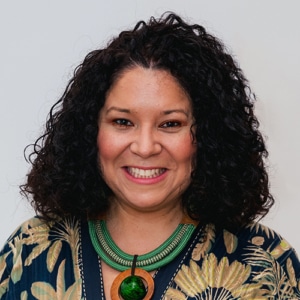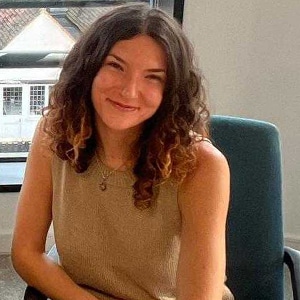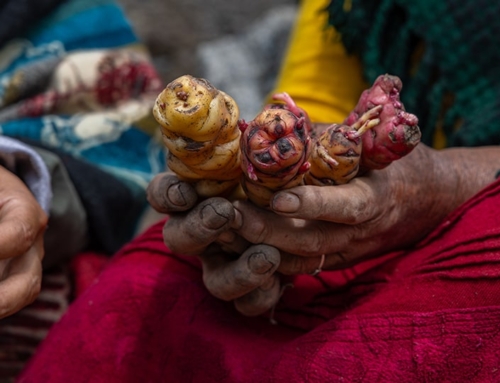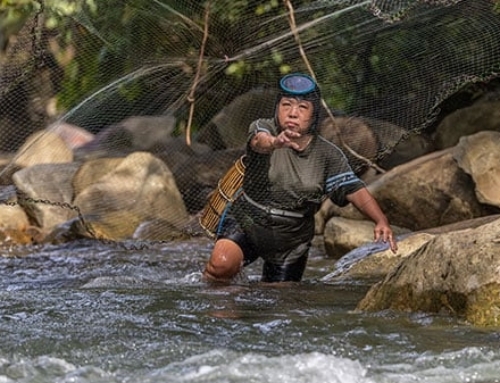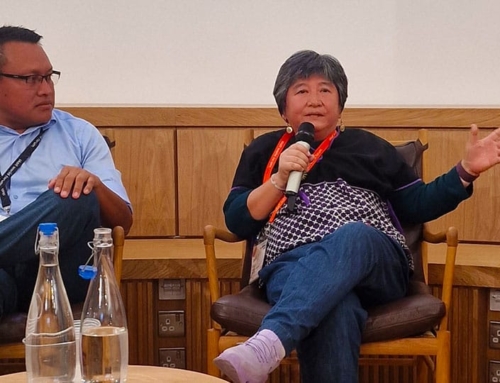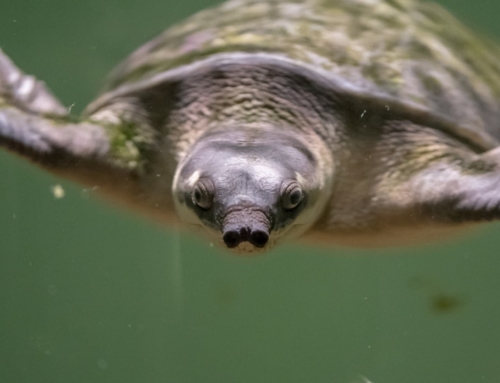Guarani peoples – native to Brazil, Argentina, Paraguay, Bolivia and Uruguay – were one of the first peoples contacted after Portuguese and Spanish colonisers arrived in South America around 500 years ago. They have been fighting to protect their land and way of life since.
In this blog, Programme Officer Bruna Miguel and Latin America Partner Relations Manager Grace Iara Souza explore how food is not just a window into the Guarani culture but a way to preserve it.
“This is the food that our deities left for us to eat. That’s why we have to respect it and plant it wisely. First, we have to baptise the food. As long as Nhanderuete and Nhandexyete allow it, we must endeavour to keep this knowledge.”
– Karai Tatadendy, Augustinho (village wisdom-keeper)
A recipe for change?
The Guarani people in the Atlantic Forest are made up of sub-groups such as the Mbyá-Guaraní and Avá-Guarani, but despite being one of the largest Indigenous peoples in Brazil, they have historically had more of their land taken from them than any other Indigenous ethnicity.
The Comissão Guarani Yvyrupa (CGY) is an Indigenous political organisation representing Brazil’s M’byá and Avá Guarani people, campaigning to legally recognise their land rights. After a 20-year struggle, in December 2024, the Guarani People celebrated the demarcation of Morro dos Cavalos Indigenous Land with the decree approved by President Lula. Seven other Guarani territories had their land recognition processes further advanced in October 2024, bringing the Guarani peoples closer to gaining full legal rights of their ancestral lands.
These victories stands to better protect over 20,000 ha of Brazil’s Atlantic Forest, but securing land is just one part of maintaining Guarani culture: preserving agroecological practices and sacred seeds is also crucial.
Tiago Karai, a young Guarani leader from the Tenondé Pora Indigenous land near São Paulo, explains the relationship between their ancestral territories, their seeds, and their culture:
“The loss of seeds meant the loss of food, sacred food, and we are only now regaining the ability to strengthen our seed stocks, our cultural knowledge, and once again protect our environment, our territory.”

Juliana Kerexu Mirim Mariano, CGY’s Executive Coordinator, sorting corn. © Carlos Emiliano
A sacred seed
Corn is a sacred food to the Guarani. In Guarani M’byá spirituality, it is believed that every Guarani household should preserve Avaxi etei seeds (a variety of corn) in their home. Those who plant using these seeds are guided and supported by Nhanderu, the Guarani God who granted the land and empowered them as rightful custodians to cultivate sacred foods.
This means agroecology is not just a means of food production, but an important cultural practice.
However, without having their territories officially recognised, it is harder for Guarani communities to ensure Land to plant their sacred seeds and maintain their biocultural diversity.
“When we talk about the struggle of the Guarani people we can’t separate the politics and spiritual work. That is why the corn is so important for the Guarani people. As long as the Guarani people can plant and there are Guarani corn plants standing, we will continue. Our elders are stubborn, they keep planting corn, medicinal plants, and trees to keep the biodiversity so that the guardians can return.”
Juliana Kerexu, Mbya Guarani leader
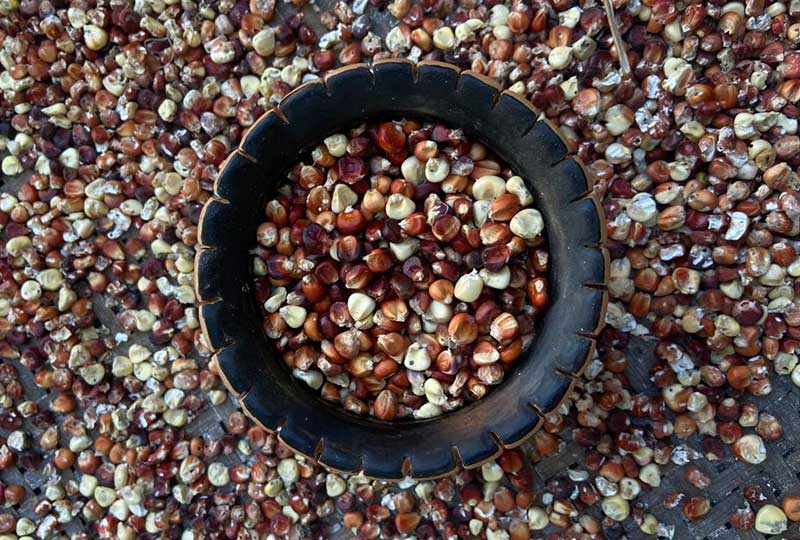
Guarani corn. © Carlos Emiliano
The recipe book gift to and from the Guarani people
As deeply cosmological peoples, the Guarani see the divine as present in Nature and all living beings. They ask for permission before hunting and celebrate when a plant is harvested.
Today, many of us have lost touch with the food we eat. We don’t know where our food comes from, how it’s reached our plates, what is in it, or whose lands its production is impacting.
This led to the production of a Guarani recipe book, Ara Pyau (new time or spring), written by Jera Guarani, alongside the community’s elders to document and pass on the significance of traditional Guarani food culture to the current generation and beyond their communities.
Ara Pyau is a gift from the older Guarani generation to the younger, providing knowledge on Guarani sacred crops, agricultural systems and eating habits – from how and when corn is cultivated to the many species of corn available from the South to the Southeast of Brazil.
Size of Wales, a climate justice charity that aims to protect tropical forests around the world, has also used the book in their ‘Indigenous Guardians of the Atlantic Forest’ workshops for schoolchildren, encouraging them to think more consciously about food consumption and even growing their own. Inspired by exchanges and learnings from the Guarani people, they have been teaching young people about the devastating impacts of soy cultivation on the Guarani People, highlighting the importance of tropical forests and the role of Indigenous Peoples in preserving them.
“Food is the foundation of our diet. If the land dies, we die as well. The Guarani are isolated. We are surrounded by agri-business producing soy and don’t have access to forests to get food, medicine. This fight won’t end today or tomorrow. We need to strengthen our seed which is our children.”
Juliana Kerexu
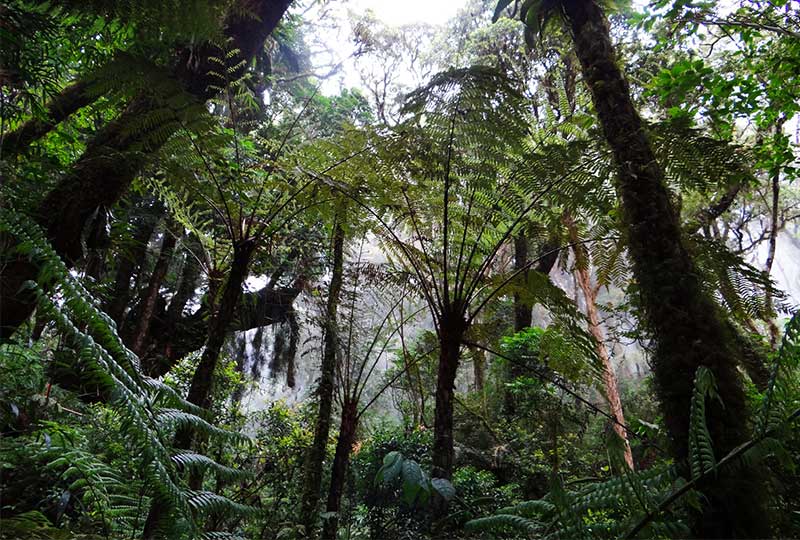
Atlantic forest. CC Adilson Brito
Food as medicine: Nourishing the next generation
The book Ara Pyau contains a range of corn-based recipes and their benefits.
Take avaxi huu va’e, for example. This variety of corn is said to be best eaten with purple sweet potatoes and is recommended for mothers in postpartum recovery.
Modern nutrition supports this. One medium sweet potato meets the daily recommendation of vitamin A for breastfeeding mothers, which is crucial for a baby’s vision, immune function, and bone growth.
Meanwhile, other research suggests that purple sweet potato leaves increase breast milk production for lactating mothers, demonstrating the valuable traditional health approaches preserved by ethnoknowledge.

Avaxi Ete, purple Guarani corn. The Guarani M’byá of the Tononde Porã village grow nine species of avaxi (corn), with beautiful diversity in size and colour. © Carlos Emiliano
Feeding the spirit
Beyond the physical body, as a sacred food, corn is thought to be especially nourishing for the soul. This practice of feeding the spirit is called nhe'ẽ.
Karai Miri (Pedro Vicente, elder) expresses the importance of Guarani continuing to consume traditional foods:
"We, the Guarani, cannot just feed our bodies. We must feed our spirit, too… In the past, the Guarani would eat healthily. This way, they didn't fall sick easily. The outside/mainstream food may look appealing and delicious but they are not good for your teeth…Me, I only eat jopara at home. I don't need any other foods."
The book also states:
"If we eat rubbish, we will fall sick, even if we continue to frequent the opy [prayer house] … The elders stress the importance of nourishment to teach the youngers about the nutrition and preparation of traditional Guarani foods."
Inspired by the Guarani people, we invite all readers to learn more about our food, what it represents to our ancestors, and how our eating habits can help nourish our bodies and souls and contribute to a better future on our shared planet.
Despite its importance, funding for protecting and reviving biocultural diversity is severely limited.
Our Biocultural Diversity Programme supports local and Indigenous People to secure land rights and preserve the ancestral knowledge that has kept their communities healthy and their territories ecologically intact.


